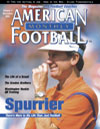AMERICAN FOOTBALL MONTHLY THE #1 RESOURCE FOR FOOTBALL COACHES
Article CategoriesAFM Magazine
|
15 Key Tips for Effective Drop Back Passingby: Steve AxmanQuarterback Coach, University of Washington © More from this issue Over the years, I have found fifteen key tips, or points, in regard to the coaching of effective drop back passing fundamentals. Although they are treated individually, they are fundamentals that build upon one another in an effort to produce a smooth, coordinated execution of the drop back pass action. It is the interrelation of the execution of these drop back passing fundamental tips that helps to produce effective drop back passing. 1. Athletic Stance - A quarterback's stance, once he has dropped back, should look much like a boxer's stance with the exception of the hold of the ball in the vicinity of the top of the quarterback's back breast. Feet should be shoulder width apart. There should be a slight bend in the knees with a feeling of the quarterback's upper body weight being displaced predominately over the balls o....The full article can only be seen by subscribers.
|
|
|||||||
| HOME |
MAGAZINE |
SUBSCRIBE | ONLINE COLUMNISTS | COACHING VIDEOS |
Copyright 2025, AmericanFootballMonthly.com
All Rights Reserved





